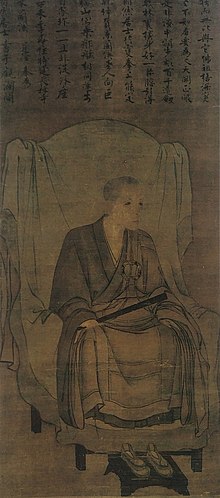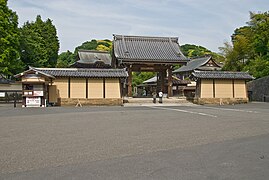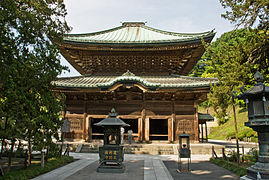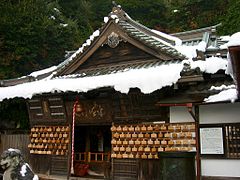Kenchō-ji
The Kenchō-ji ( Japanese 建 長 寺 ), detailed and with the name of the mountain Kyofukusan Kenchō kōkoku zenji ( 巨 福山 建 長 興国 ), is a main Buddhist temple of the Rinzai school of Japanese Zen in Kamakura , Kanagawa Prefecture . The temple has about 500 branch temples across Japan.
history
The Kenchō-ji was built in 1253 by the fifth Hōjō - Shikken , Hōjō Tokiyori , with the support of the Go-Fukakusa -tennō and was named after the current government motto Kenchō . At this time, Kamakura was the seat of government of the Kamakura Shogunate and thus de facto the capital of Japan.
At the invitation of Tokiyori and the Go-Saga -tennō, the Chinese Chan monk Lanxi Daolong ( Chinese 蘭溪 道 隆 , Pinyin Lánxī Dàolóng , W.-G. Lan-hsi Tao-long ; Japanese 蘭 渓 道 隆 , Rankei Dōryū ; 1213– 1278) to the temple and held the position of head of the temple until 1259, when he moved to the Kennin-ji in Kyōto . His successor was Wuan Puning ( 兀 菴 普寧 , Wùān Pǔníng , Wu-an P'u-ning ; Japanese Gottan Funei; 1197–1276). Lanxi Daolong was again the third head.
The Kenchō-ji housed the Chinese Chan monks Daxiu Zhengnian ( 大 休 正念 , Dàxiū Zhèngniàn , Ta-hsiu Cheng-nien ; Japanese Daikyū Shōnen; 1214–1289), Wuxue Zuyuan ( 無 學 祖 元 , Wúxué Zǔyuán , Wu-hsüeh Tsu-yüan ; Japanese Mugaku Sogen; 1226–1286), Qingzhuo Zhengcheng ( 淸 拙 正 澄 , Qīngzhuó Zhèngchéng , Ch'ing-cho Cheng-ch'eng .; ; 1274-1339).
Since the Kamakura period , the Kenchō-ji was the first of the Gozan temples in Kamakura, making it one of the most influential temples in all of Japan, although it was destroyed several times by fires and the like. a. Damaged in 1315 and 1414 as well as by the severe earthquake in 1923.
From 1905 the temple was headed by the abbot Sugawara Tokiyasu , who was also the chief of the Kenchō-ji branch of the Rinzai.
The attachment
( ⦿ = national treasure , ◎ = important cultural asset of Japan ) The Kenchō-ji was built into a mountain niche and runs from the entrance in northeast direction. The temple is a typical Zen complex and comprises the following buildings in a central arrangement:
- Outside gate ( 総 門 , sōmon), also called "Great Fortune Gate" ( 巨 福 門 ) here. It was originally in the Hanshū-Zammai Temple ( 槃 舟 三味 院 , Hanshū-zammai-in ) in Kyoto.
- The ◎ main gate ( 山門 , sammon ) was built in 1754 by Bansetsu, the abbot at the time. An Amida Buddha is set up on the upper floor and is surrounded by the 500 rakan .
- In the bell tower ( 鐘楼 , shōrō ) hangs a ⦿ bell ( 梵 鐘 , banshō ), which was cast in 1255 and contains an inscription by the temple founder. It weighs 2.7 tons.
- Between the Sammon and the Buddha Hall, the path is lined with seven large Chinese juniper trees . These were planted when the temple was founded and are now up to 7 m high and have been designated as a special historical heritage ( 名勝 史跡 , meishō shiseki ).
- The ◎ Buddha Hall ( 仏 殿 , butsuden ) was moved here in 1647 from the Zōjō-ji ( 増 上 寺 ), an influential temple of Amida Buddhism in Tokyo , where it was part of the burial place of the wife of the shogun Tokugawa Hidetada . The main cult figure is Jizō , the protector of the poor and children. Together with the pedestal, the sculpture is 495.5 cm high. It was probably created after the major fire of 1414 when the original sculpture had to be replaced. Next are Garanjin ( 伽藍神 ), protector seen from temples.
- The ◎ teaching hall ( 法堂 , hattō ), dates back to 1814. Originally without a cult figure, a Kannon is now worshiped. The hall is the largest wooden building in eastern Japan.
- In front of the abbot's quarters ( 方丈 ) is the ◎ Karamon ( 唐門 ), a gate in the so-called Chinese style, which, like the Buddha hall, comes from the temple grounds of the Zōjō-ji. The Karamon is also called "Gate for the Imperial Messenger" ( 勅使 門 , chokushimon ).
- The abbot building ( 方丈 ) is also called "Palace of the Dragon King" ( 龍 王殿 , Ryūōden ).
- Behind the abbot building you can see the garden designed by Rankei, which has been recognized as a special historical heritage. It surrounds a pond in the shape of the character for heart ( 心 字 池 , shinji-ike ). The pond is also called Sanpekichi ( 蘸 碧 池 ).
- On the edge of the temple area up on the mountain is the small Hansobo shrine ( gel 僧坊 ). He was brought here in 1890 at the request of the abbot Ozora Kandō of the Hōkō-ji in Shizuoka Prefecture . There, Hansobo Gongen is venerated as the protector of the temple.
- The monastery buildings, which are located on the southeast side behind a gate, the Shūsanmon ( 嵩山 門 ), cannot be visited. There is the Sairai-an ( 西 来 庵 ) and the hall of the founder, Kaizandō ( 開山 堂 ).
From the collection
- ⦿ Scroll of the temple founder Rankei Dōryū
- ◎ Sculpture of Hōjō Tokiyori (1227–1263)
photos
literature
- Kenchoji Temple brochure, 1963, 60 pp.
- Folder of the temple
Web links
- Official Website (Japanese)
- Information of the College of Japanese Rinzai and Obaku Zen (English)
- Information of the city of Kamakura (English)
- Information on A Guide to Kamakura (English)
- Information on Kamakura Citizens Net (English)
Coordinates: 35 ° 19 ′ 54.4 ″ N , 139 ° 33 ′ 19.2 ″ E








